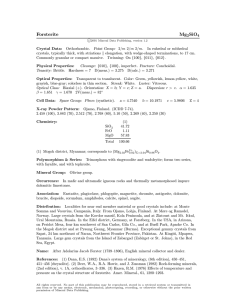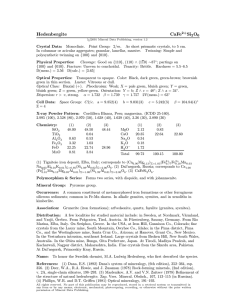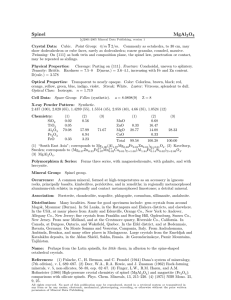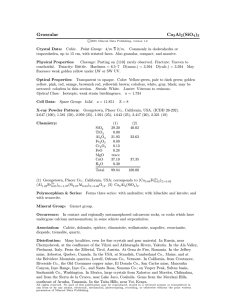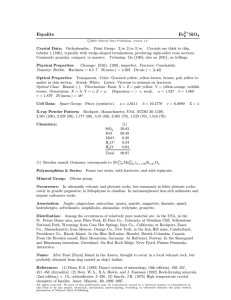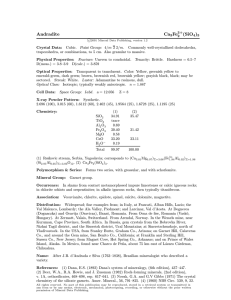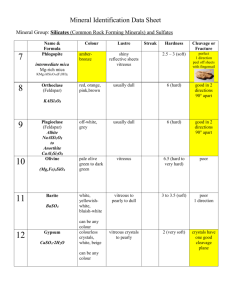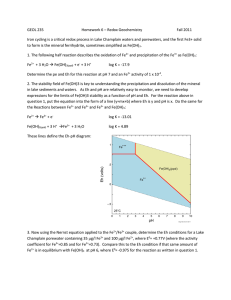Diopside CaMgSi O
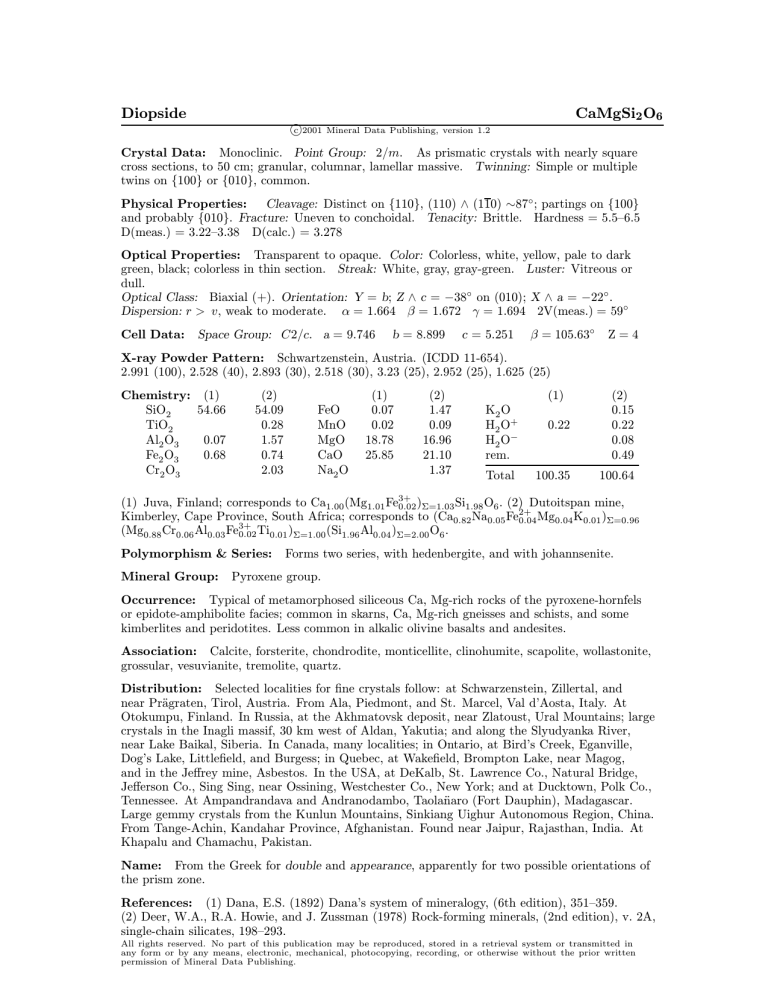
Diopside CaMgSi
2
O
6
°
2001 Mineral Data Publishing, version 1.2
Crystal Data: Monoclinic.
Point Group: 2 =m: As prismatic crystals with nearly square cross sections, to 50 cm; granular, columnar, lamellar massive.
Twinning: Simple or multiple twins on f 100 g or f 010 g , common.
Physical Properties: Cleavage: Distinct on
D(meas.) = 3.22{3.38
D(calc.) = 3.278
f 110 g , (110) ^ (110) » 87
±
; partings on f 100 g and probably f 010 g .
Fracture: Uneven to conchoidal.
Tenacity: Brittle. Hardness = 5.5{6.5
Optical Properties: Transparent to opaque.
Color: Colorless, white, yellow, pale to dark green, black; colorless in thin section.
Streak: White, gray, gray-green.
Luster: Vitreous or dull.
Optical Class: Biaxial (+).
Orientation: Y = b ; Z ^ c = ¡ 38 ± on (010); X ^ a = ¡ 22 ± .
Dispersion: r > v; weak to moderate.
® = 1.664
¯ = 1.672
° = 1.694 2V(meas.) = 59
±
Cell Data: Space Group: C 2 =c: a = 9.746
b = 8.899
c = 5.251
¯ = 105 : 63
±
Z = 4
X-ray Powder Pattern: Schwartzenstein, Austria. (ICDD 11-654).
2.991 (100), 2.528 (40), 2.893 (30), 2.518 (30), 3.23 (25), 2.952 (25), 1.625 (25)
Chemistry: (1)
SiO
TiO
Al
Fe
2
2
Cr
2
2
2
O
O
O
3
3
3
54.66
0.07
0.68
(2)
54.09
0.28
1.57
0.74
2.03
FeO
MnO
(1)
0.07
0.02
MgO 18.78
CaO
Na
2
O
25.85
(2)
1.47
0.09
16.96
21.10
1.37
(1)
K
2
H
H
2
O
O
2
O rem :
+
¡
0.22
Total 100.35
(2)
0.15
0.22
0.08
0.49
100.64
(1) Juva, Finland; corresponds to Ca
1 : 00
Al
0 : 03
Fe
3+
0 : 02
Ti
(Mg
1 : 01
)
§=1 : 03
Kimberley, Cape Province, South Africa; corresponds to (Ca
0 : 82
(Mg
0 : 88
Cr
0 : 06 0 : 01
)
§=1 : 00
(Si
1 : 96
Al
Fe
0 : 04
)
3+
0 : 02
§=2 : 00
O
6
:
Si
1 : 98
O
6
:
Na
0 : 05
(2) Dutoitspan mine,
Fe
2+
0 : 04
Mg
0 : 04
K
0 : 01
)
§=0 : 96
Polymorphism & Series: Forms two series, with hedenbergite, and with johannsenite.
Mineral Group: Pyroxene group.
Occurrence: Typical of metamorphosed siliceous Ca, Mg-rich rocks of the pyroxene-hornfels or epidote-amphibolite facies; common in skarns, Ca, Mg-rich gneisses and schists, and some kimberlites and peridotites. Less common in alkalic olivine basalts and andesites.
Association: Calcite, forsterite, chondrodite, monticellite, clinohumite, scapolite, wollastonite, grossular, vesuvianite, tremolite, quartz.
Distribution: Selected localities for ¯ne crystals follow: at Schwarzenstein, Zillertal, and
Otokumpu, Finland. In Russia, at the Akhmatovsk deposit, near Zlatoust, Ural Mountains; large crystals in the Inagli massif, 30 km west of Aldan, Yakutia; and along the Slyudyanka River, near Lake Baikal, Siberia. In Canada, many localities; in Ontario, at Bird's Creek, Eganville,
Dog's Lake, Little¯eld, and Burgess; in Quebec, at Wake¯eld, Brompton Lake, near Magog, and in the Je®rey mine, Asbestos. In the USA, at DeKalb, St. Lawrence Co., Natural Bridge,
Je®erson Co., Sing Sing, near Ossining, Westchester Co., New York; and at Ducktown, Polk Co.,
Large gemmy crystals from the Kunlun Mountains, Sinkiang Uighur Autonomous Region, China.
From Tange-Achin, Kandahar Province, Afghanistan. Found near Jaipur, Rajasthan, India. At
Khapalu and Chamachu, Pakistan.
Name: From the Greek for double and appearance , apparently for two possible orientations of the prism zone.
References: (1) Dana, E.S. (1892) Dana's system of mineralogy, (6th edition), 351{359.
(2) Deer, W.A., R.A. Howie, and J. Zussman (1978) Rock-forming minerals, (2nd edition), v. 2A, single-chain silicates, 198{293.
All rights reserved. No part of this publication may be reproduced, stored in a retrieval system or transmitted in any form or by any means, electronic, mechanical, photocopying, recording, or otherwise without the prior written permission of Mineral Data Publishing.
